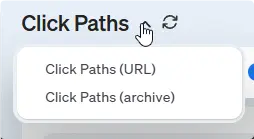Click paths
In addition to the question of engagement with individual pages, it is informative to look at the paths taken by visitors. The sequence of pages visited is referred to as a click path. Within the click path report, the flow of visitors to the website is displayed visually and in tabular form.
To do this, select the desired page in the table from which the further behavior flow is to be viewed.

From the page being viewed, the top 5 or top 10 most frequently accessed pages can be analyzed in the tree diagram.

It is also possible to click on one of the following pages to examine an individual strand separately. Longer page names are shortened, but can be displayed in full on mouseover.

If the page name is fed from the page title by default (which can be changed via Account → Automatic entry: Page names ), but the URL is more suitable for the analysis, the click path analysis can always be switched to the page URL. To do this, click on the arrow to the right of the report title and select
